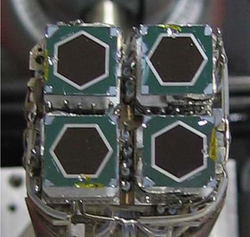Apr 26 2010
The 50 mm<sup>2</sup> silicon drift detectors (SDD) designs have been customized by SII NanoTechnology USA (SIINT) recently. This initiative has resulted in boosting the high rate capability and allowing positioning of SDD below a sample with optimized proximity and reducing the signal gathering time.
 SIINT Designs 4 Element SDD Arrays
SIINT Designs 4 Element SDD Arrays
The company has also enhanced a 50 mm<sup>2</sup> SDD design through a larger solid angle and assembled it inside a transmission electron microscope (TEM) at the Argonne National Laboratory’s (ANL) Electron Microscopy Center. This design permits the detector’s native area to be positioned under the sample directly. This close geometry design, also known as close sample to detector geometry, helps to maximize the solid angle, resulting in better sensitivity and increased count rate.
The four SDD elements are placed in a square layout. A sophisticated heat transfer technique removes the heat from these elements, followed by cooling the detectors with Peltier coolers. The active area of the four-element design spans 180 mm<sup>2</sup> and its output rate is 2 Mcps. The large active area was addressed by the company by making a four-element array using four-channel electronics. This SDD spectrometer is currently utilized for high rate synchronizing applications that need high detection efficiency and large solid angle.
According to SIINT’s Chief Technical Officer and Sr. Vice President Shaul Barkan, the SDD arrays have replaced customary multi-element germanium detectors that are cooled by heavy liquid nitrogen (LN).
SIINT’s Vice President of Sales and Marketing Gordon Myers, informed that the new SDDs provide great energy resolution, high count rate performance and a large solid angle. He revealed that it is useful for the nanoparticles’ characterization at high spatial resolution. Since this capability is very crucial for advanced materials research, the company will continue developing nanotechnology equipment that will be used in applications, such as X-ray fluorescence and X-ray spectroscopy measurements, according to Myers.